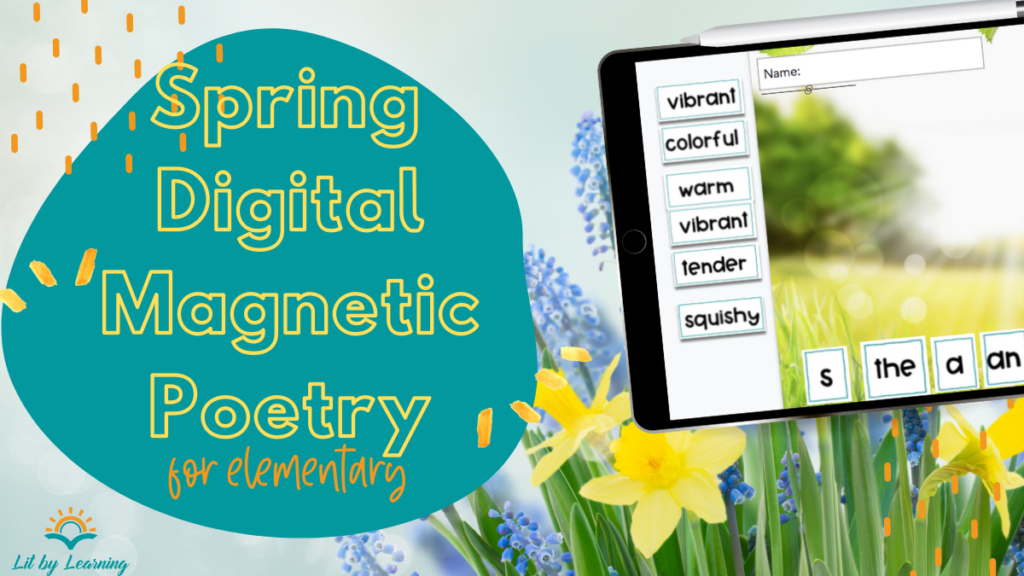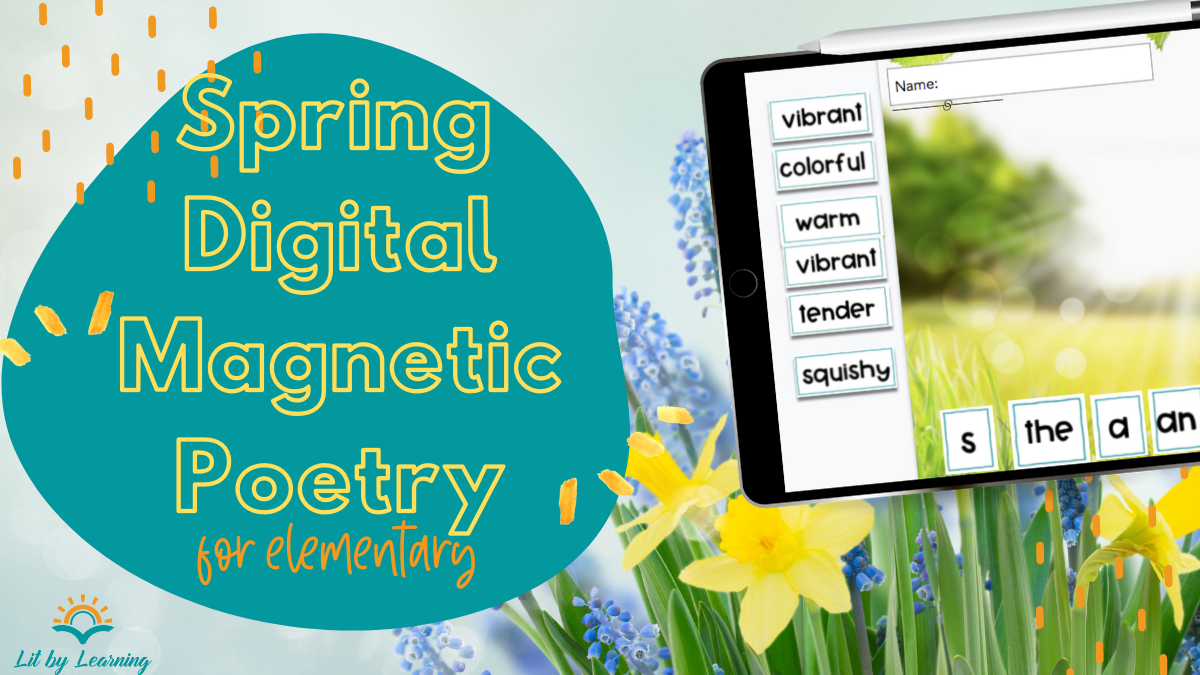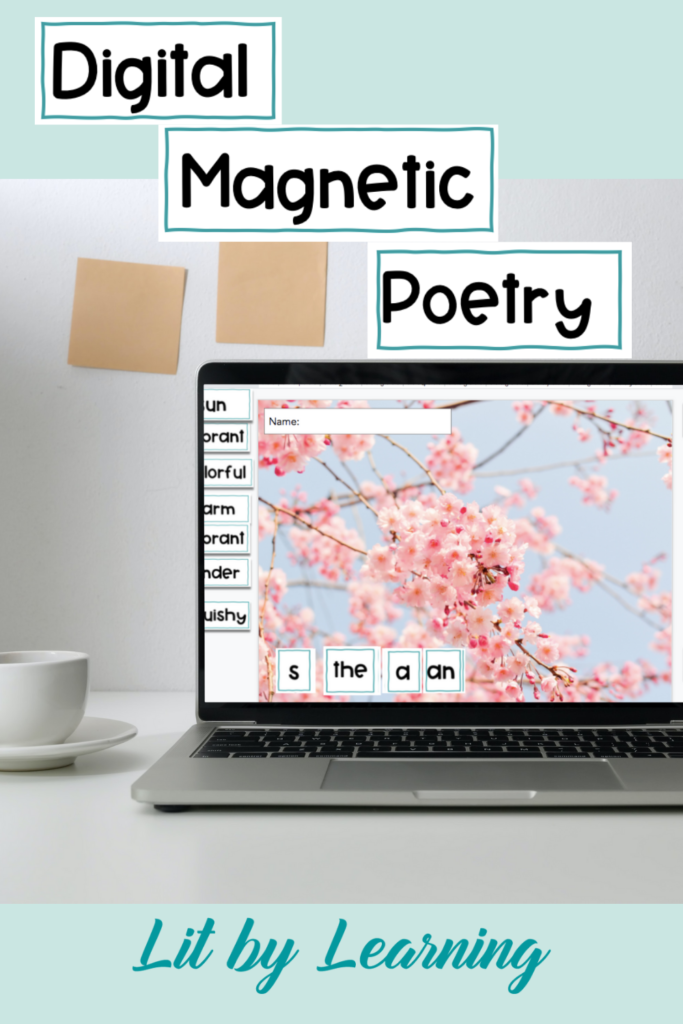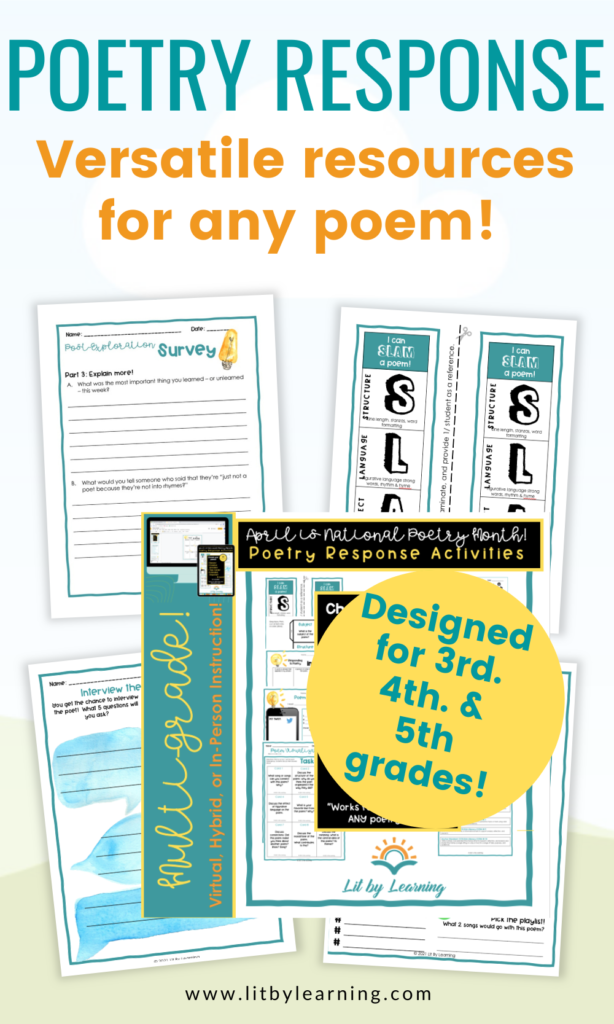National Poetry Month is officially here! Have you ever tried digital magnetic poetry with your elementary students?! Read on to find out why this is quickly one of my first graders’ favorite literacy center choices!

The allure of magnetic poems
Did anyone else have those little poetry magnets growing up? The ones you’d secretly arrange while your mom wasn’t looking to make fridge magnet words that would crack your sister up? Ok, maybe I zoomed in too close on that one…
I loved these magnetic poem tiles because they let me play with words… wonderful words. Words I mostly know what they meant, but definitely couldn’t spell (yet). Juicy, delicious words. REAL POET words. I loved that I could move them around without worrying about their spelling… I just got to use them as MINE.
That’s still part of the magical allure of those magnetic tiles still today: they provide access to “fancy” words while being whimsical and playful. They allow even young students to “own” sophisticated words, blending them into a poetry creation of their own. They provide access to writing above one’s reading (and writing!) level in a way that feels… empowering.
Magnetic poetry tiles provide access to writing above one’s reading (and writing!) level in a way that feels… empowering.
Magnet poetry online
Online magnetic poetry is an amazing tool for teaching poetry in an elementary classroom. Students drag and drop words, creating impressive combinations that bring clear images to the readers’ eyes. When I hosted an elementary poetry club last school year, we played on sites like MagneticPoetryOnline as a warm-up to our sessions. The students (and I) delighted in our word combinations, setting a playful, poetry-is-for-everyone vibe that we could carry throughout our gatherings.
We also used magnet poetry online to play with mood and shades of meaning. What seeming synonyms could we use to create a different mood in our poems? How did changing just one word affect how we felt while reading the poem? The simple drag and drop format allowed us to dedicate our real efforts to choosing pinpointed words. The students weren’t caught up in how to spell things or make the letters look right. We were able to really focus on precise word choice: an essential for poets.
Playing with how to make your own poetry
Another reason I’m a fan of digital magnetic poetry is that it’s an engaging exercise in how to make your own poetry. Especially younger elementary students can be intimidated by the heavy cognitive load of writing poetry. Digital magnet poetry adds a playful element. Plus, it already looks nice, so it somehow feels more “legit” or “real” than what they may scrawl in their notebooks (though these are my personal favorites!).

Why I created my own digital magnetic poetry sets
There are a ton of great free resources out there, so why did I create my own digital magnetic poetry sets?!
Empower elementary poets with their own words
First, I wanted to include students’ ideas. Yes, I wanted to “gift” them some words that may not be in their vocabulary (yet!), but I also wanted them to see that their ideas work, too! Most of the poetry sets I’ve published are lists I’ve made cooperatively with my students. They get a big boost of confidence from seeing their words added to the “official” list!
Digital magnetic poetry… just for us
The second reason I created digital magnetic poetry sets for our class is that I wanted to dial in a bit. Especially with English Language Learners and early readers, I found that the pre-made sets could be a bit overwhelming. My students had trouble wading through all the words. I created our customized sets to cut out the busyness a bit. Fewer, more focused words worked well for us!
Digital magnetic poetry with a touch of grammar
A third reason I crafted our own poetry tiles is that I wanted to combine teaching the parts of speech. Call me a grammar nerd, but I wanted to color-code which words were nouns, adjectives, verbs, articles, and adverbs. Did I emphasize this heavily with students as they were creating? No! Poetry is about breaking rules and having fun. But did they accidentally learn about why some words are pink and why others are green? Maybe. These color-coded options also allowed me to craft a simple mapping sequence for my multilingual students. They could follow the color-coded formula of article – adjective – noun – verb -adverb with confidence, which lit up my teacher heart!
Poetry is about breaking rules and having fun.
Digital magnetic poetry and beyond!
Those of you who have been here at Lit By Learning for a while can see that I LOVE poetry in all its forms. I actually (unpopular opinion alert!) tend more towards paper and pencil options, especially for elementary poets. Please make sure to check out my resources and posts for more about how I teach poetry in our cross-curricular, inquiry-based first-grade room!
Check out my children’s poetry book recommendations!
More poetry resources from Lit By Learning!
For more about teaching poetry to elementary children, please make sure to check out my other blog posts!:




